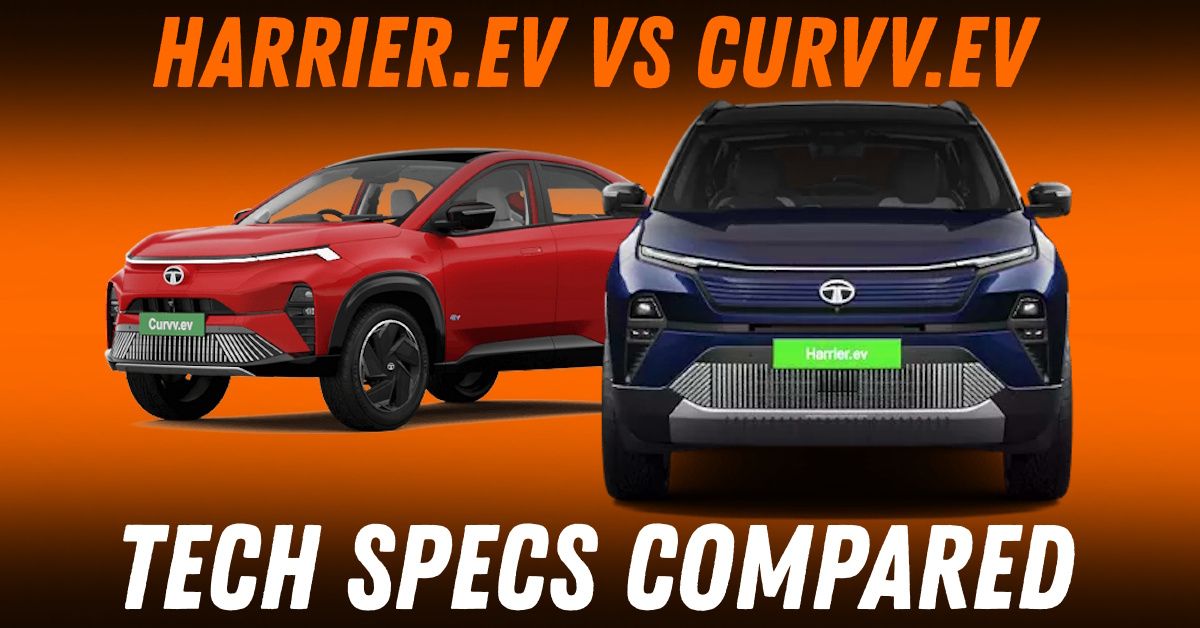Tata Harrier EV vs Tata Curvv EV: Tech Specs Compared


The electric SUV space in India is finally entering its next phase. No longer confined to small city hatchbacks or premium electric SUVs priced well over ₹30 lakh, carmakers are now competing to win over the sweet spot. Buyers willing to spend between ₹20 to 25 lakh. Tata Motors, which already enjoys a significant EV market share with the Nexon EV, has now doubled down with two very different offerings at this price point: the coupe-styled Tata Curvv EV and the more rugged, upright Tata Harrier EV. Both are electric, both hover around the ₹22 lakh mark, but the experience they offer couldn’t be more different.
The Curvv EV is built for those who want to stand out. With its coupe-like sloping roofline, gloss-black cladding, and youthful proportions, the Curvv looks like it belongs to a future where SUVs have taken a more aerodynamic and urban-friendly form. It’s clearly designed with the younger buyer in mind, someone who values edgy design over brute stance.
The Harrier EV, on the other hand, sticks to more traditional SUV proportions. It’s bigger in every dimension, looks more muscular, and offers that reassuring road presence that SUV buyers still crave. Even in its electric form, the Harrier feels like a proper full-size SUV, not a compact crossover trying to punch above its weight.
When it comes to what’s under the skin, the differences are substantial. The Curvv EV is offered in two battery configurations, 45 kWh and 55 kWh, with an expected MIDC range between 502 and 585 km. It’s front-wheel driven and offers decent real-world performance, but it’s not meant to excite you on the highway.
The Harrier EV, however, is playing in a higher league. With a 65 kWh or optional 75 kWh LFP battery, dual-motor AWD, and up to 627 km MIDC range, it offers genuine long-distance ability and impressive performance. It can hit 0 to 100 km/h in just over 6 seconds, a feat usually reserved for far more expensive EVs.
This is where the Harrier EV stretches its legs. With more than 500 litres of boot space and an additional 67-litre frunk (front trunk), it’s the more practical of the two. The Curvv EV also offers generous boot space at 500 litres, but its 11.6-litre frunk feels more like a design formality than a usable compartment.
Wheelbase is another giveaway. The Harrier’s 2,741 mm wheelbase translates into better rear seat comfort and more relaxed highway cruising manners. The Curvv, while comfortable for four, is better suited for urban commuting and shorter weekend getaways.
Tata hasn’t held back on safety and features in either SUV. The Curvv has already secured a 5-star Bharat NCAP rating, comes with six airbags, ESP, and ADAS Level 2 features. The Harrier EV mirrors and even builds on that with up to seven airbags, electronic parking brake, a 540-degree camera, and over-the-air update capability.
The Curvv EV is priced between ₹18 to 22 lakh, making it one of the most feature-rich EVs in its segment without stretching your budget too far. The Harrier EV starts at ₹21.49 lakh and is expected to go up to ₹28 lakh depending on the variant. That puts it in the upper end of the mid-size EV bracket, bordering on premium.
If you’re a tech-savvy urban buyer looking for a futuristic, stylish electric car under ₹22 lakh, the Curvv EV checks nearly all boxes. But if you value space, versatility, and performance and are willing to spend a few lakhs more for a more complete package, the Harrier EV feels like money better spent.
Ultimately, this isn’t just a battle of specs. It’s a reflection of how varied buyer expectations are within India’s emerging EV market. And that’s a great problem for Tata to have.